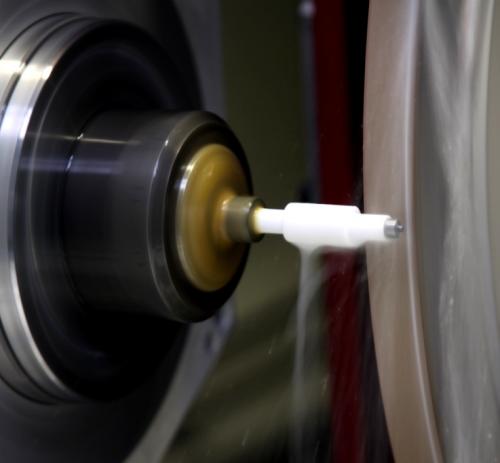General principle
Precision grinding is carried out after the sintering (firing) cycle. It involves fully grinding a raw material or grinding a part that has already been formed to its final finish. This process enables the economic production of prototype parts or runs with a shape/tolerance ratio that cannot be attained by moulding or pressing.
Detailed description
Grinding uses traditional machining equipment (machining centres, grinding and lapping machines, etc.) but fitted with a more robust structure to resist wear resulting from the hardness and abrasion of these ceramics. These machines are fitted with diamond tools (millstones, hollow drills, lapping and honing tools, etc.) and operate in water lubrication. Lastly, the high rotation speeds of the tool and ability to take material with a precision accuracy of a few hundredths of a millimetre also differentiate the machining of advanced ceramics from the traditional machining of metals.
Long regarded as a method only suitable for creating prototypes without tooling costs, or in addition to moulding and pressing techniques, to provide dimensional and/or geometric precision on sintered parts, the precision machining of ceramics is now an entire process in its own right. It has evolved significantly due to the technical development of machines which have become efficient and accurate and are able to manufacture medium-scale runs of complex parts and/or with tight tolerances at competitive costs.
Materials involved
All the advanced ceramics, as well as sapphire and quartz, can be machined by grinding. There are, however, some minor machining differences from one material to the next. In particular, drilling and milling very hard ceramics, such as silicon carbide and silicon nitride, is difficult using traditional methods. In that case, machining with ultrasound should be used.
Advantages and disadvantages of this process
- Low tool costs
- Shorter lead times for prototypes
- Can obtain tight tolerances and complex geometries
- Process can be adapted to all types of advanced ceramics
- Process not suitable for large and very large runs (tens of thousands and above)
- Unit cost higher than pressing or moulding.
